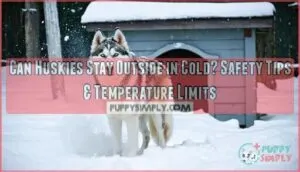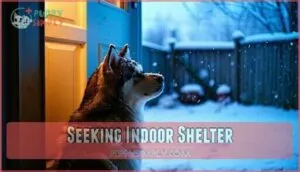This site is supported by our readers. We may earn a commission, at no cost to you, if you purchase through links.

However, you’ll need to provide proper shelter, monitor for distress signals, and understand your dog’s individual limits.
Watch for signs like shivering, paw lifting, seeking indoor shelter, or reduced activity that indicate your husky’s reaching their comfort threshold.
Puppies lack full adult coats and need extra protection through heated pads, winter coats, and increased calories.
Even cold-hardy adult huskies require windproof shelter with proper insulation and strategic placement.
Age, health, and acclimatization all influence how well your husky handles frigid temperatures and determines their outdoor safety limits.
Table Of Contents
- Key Takeaways
- Cold Tolerance of Huskies
- Signs of Husky Discomfort in Cold
- Ensuring Husky Safety in Low Temperatures
- Winter Care for Husky Puppies
- Factors for Husky’s Cold Adaptation
- Determining Outdoor Suitability
- Recommendations for Husky Care
- Frequently Asked Questions (FAQs)
- Can Huskies stay outside in the snow?
- Can Huskies survive cold weather?
- What happens if a husky is outside in the Cold?
- Should Huskies be left outside all night?
- What are the signs that a Husky is too cold?
- What kind of shelter does a Husky need in the winter?
- What kind of grooming do Huskies need in the winter?
- How much exercise should a Husky get in the winter?
- What are some common health problems for Huskies in the winter?
- How does wind chill affect husky cold tolerance?
- Conclusion
Key Takeaways
- Your husky can handle cold weather down to -50°F thanks to their double-layered coat, but you’ll need to provide proper windproof shelter with insulation and monitor them for signs of distress like shivering or paw lifting.
- Watch for behavioral cues that signal your husky’s getting too cold – including seeking indoor shelter, reduced activity, excessive paw licking, and body language changes that indicate they’ve reached their comfort threshold.
- Puppies need extra protection since they haven’t developed their full adult coat yet – provide heated pads, winter coats, increased calories, and closer monitoring as their bodies can’t regulate temperature as effectively as mature dogs.
- Your husky’s outdoor safety depends on individual factors like age, health, acclimatization, shelter quality, and companionship needs – even cold-hardy adult huskies require proper preparation and shouldn’t be left alone without adequate proper protection.
Cold Tolerance of Huskies
Your husky’s exceptional cold tolerance stems from remarkable coat insulation—a double-layered system providing thermal protection down to -50°F (-45°C).
However, acclimatization factors like age, health, and previous cold exposure substantially impact their physiological limits.
While breed variations exist, most huskies handle temperature extremes well with proper preparation, and their bodies adapt through increased metabolism and circulation changes.
Yet even these cold-weather champions need monitoring during extreme cold conditions to prevent overexertion of their natural defenses.
Signs of Husky Discomfort in Cold
Even the cold-loving Husky has limits, and recognizing when your dog feels uncomfortable can prevent serious health issues.
Watch for clear behavioral signals that indicate your Husky needs warmth and shelter immediately.
Seeking Indoor Shelter
When your husky repeatedly tries to come indoors or lingers by doors and windows, they’re signaling discomfort with outdoor conditions.
This behavior indicates their natural cold tolerance has limits. Providing proper shelter with adequate insulation becomes essential for outdoor safety.
Indoor benefits include family bonding and emotional well-being, preventing isolation during harsh cold weather while ensuring nighttime warmth.
Lethargy can also be a sign, so monitor your husky for behavioral changes, which may indicate they need extra care for their natural cold tolerance and overall emotional well-being.
Shivering
Muscle contractions become your Husky’s primary defense mechanism when cold temperatures push beyond their comfort zone.
Shivering intensity increases as environmental conditions worsen, with shivering frequency escalating from occasional tremors to persistent episodes.
Underlying causes include inadequate shelter, wet conditions, or prolonged exposure below freezing. Smaller dogs are more susceptible because of faster body heat loss.
Shivering thresholds vary by individual health and acclimatization. Immediate shivering remedies prevent dangerous hypothermia progression.
Body Language Cues
Beyond shivering, your dog’s body language reveals hidden anxiety signals that demand attention.
Huskies communicate distress through subtle physical cues that often precede more obvious disorientation signs.
- Paw lifting: Alternating between lifted paws indicates cold ground contact discomfort
- Burrowing behavior: Seeking enclosed spaces or digging suggests instinctive warmth-seeking responses
- Licking paws: Excessive grooming of extremities signals ice buildup or early frostbite concerns
Paw Sensitivity
Paw pads face the brunt of winter’s harsh conditions.
Watch for frequent paw lifting – your dog’s way of saying the ground’s too cold for comfort. Excessive paw licking often signals irritation from salt or ice buildup between toes.
Cold paws mean it’s time to head inside—your husky’s telling you the ground’s too harsh for comfort
Dog boots provide excellent frostbite prevention, while paw balm creates a protective barrier against cold temperatures and salt irritation.
- Paw lifting from cold surfaces
- Excessive licking due to salt irritation
- Visible cracks or red, swollen paw pads
- Ice balls forming between toes
Reduced Activity
When your dog’s usual zoomies turn into slow-motion walks, cold temperatures might be draining their energy levels.
Limited mobility becomes apparent as joint stiffness sets in from extreme cold exposure.
| Sign | Possible Cause |
|---|---|
| Decreased appetite | Energy conservation mode activated |
| Dull coat | Reduced circulation from cold stress |
| Lethargy | Body prioritizing core warmth over activity |
| Increased shivering | Muscle contractions generating heat |
| Difficulty walking | Joint stiffness from temperature drop |
Watch for these telltale signs that your husky needs warmth:
- Your normally bouncy dog moves like they’re walking through molasses
- They choose napping over their favorite games and mental stimulation
- Getting up from lying down takes extra effort and time
- Their usual enthusiasm for walks disappears completely
- Weight management becomes challenging due to reduced exercise tolerance, which can lead to energy conservation mode and impact their overall health and well-being.
Ensuring Husky Safety in Low Temperatures
When temperatures drop below your husky’s comfort zone, proper shelter becomes the difference between safety and serious health risks.
You’ll need to understand the essential components of cold-weather protection to keep your dog healthy and comfortable outdoors.
Providing Adequate Shelter
Providing proper shelter becomes your first line of defense against harsh winter conditions. Your dog house should be spacious enough for movement yet compact enough to trap body heat effectively.
| Shelter Feature | Recommendation |
|---|---|
| Size | Allow standing/turning, retain warmth |
| Location | Elevated, wind-protected area |
| Bedding | Straw for snow, blankets for dry climates |
Huskies need wind protection and dry insulation to maintain their natural cold weather resilience. Consider dog house insulation options to enhance warmth. Strategic shelter placement away from prevailing winds creates a microclimate that keeps your dog comfortable even when temperatures plummet.
Shelter Insulation
Proper shelter insulation transforms your dog house from basic protection into a thermal fortress.
Quality insulation materials create the barrier between comfort and cold stress for outdoor huskies.
Here are five essential insulation strategies:
- Insulation Materials: Use foam boards with R-values of 3.6-4.2 per inch for superior thermal resistance and moisture protection.
- Shelter Size: Build just large enough for standing and turning—smaller spaces retain your husky’s body heat more effectively.
- Bedding Options: Choose straw or wood chips over blankets, as natural materials stay dry and maintain insulation properties.
- Dampness Prevention: Elevate the doghouse four inches off ground and seal all gaps to block moisture infiltration.
- Location Matters: Position shelter away from prevailing winds while ensuring proper ventilation to prevent condensation buildup.
Consider providing windproof shelter for ideal protection.
Benefits of Shelter Door
Heat retention becomes your Husky’s lifeline when temperatures plummet.
A shelter door transforms your dog house into a fortress against harsh elements, blocking wind and trapping warm air inside. This simple addition creates a microclimate that’s several degrees warmer than outside conditions.
German Shepherds, similar to Huskies, also benefit from adequate shelter in the cold, but their temperature tolerance varies.
| Door Feature | Benefit |
|---|---|
| Wind Protection | Blocks cold drafts from entering shelter |
| Heat Retention | Traps body heat inside doghouse |
| Weather Barrier | Prevents rain and snow infiltration |
| Draft Reduction | Eliminates air circulation that steals warmth |
| Privacy Provision | Creates secure space for Huskies to rest |
Your shelter door works like insulation for an entire room—without it, all that precious body heat escapes.
Winter Care for Husky Puppies
Husky puppies lack the full adult double coat that provides superior insulation, making them substantially more vulnerable to cold temperatures than mature dogs.
Young huskies need winter’s gentle touch—their puppy coats can’t brave the cold like their grown-up counterparts
You’ll need to provide extra warmth and monitor them closely, as their developing bodies can’t regulate temperature as effectively in harsh winter conditions, which makes them require extra care.
Lack of Cold Tolerance
Unlike adult Huskies, puppies haven’t developed their full winter coat or mature thermoregulation abilities.
Age factors substantially impact cold tolerance, making young Huskies vulnerable to hypothermia and frostbite even in moderately cold conditions.
Individual variation means some puppies struggle more than others, regardless of coat condition or acclimatization impact.
- Health conditions like malnutrition or illness further reduce temperature tolerance in young Huskies
- Coat development takes months to reach adult thickness, leaving puppies exposed to cold stress
- Body size means puppies lose heat faster than adults, requiring closer monitoring outdoors
Behavioral Cues
When something’s not right, your husky puppy will tell you through clear behavioral signals that shouldn’t be ignored.
Watch for anxiety signals like hunched posture and tucked tails, plus burrowing behavior as they seek warmth. Remember to watch for signs of discomfort, as frostbite and hypothermia can be dangerous.
- Paw lifting – Alternating lifted paws indicate cold discomfort
- Licking paws – Excessive licking suggests ice buildup or frostbite onset
- Disorientation signs – Confusion or sluggish movement signals hypothermia risk
- Burrowing behavior – Seeking enclosed spaces shows warmth-seeking instincts
- Anxiety signals – Whining, restlessness, or reluctance to move outdoors
Additional Warmth Needs
Husky puppies need additional warmth support during winter months.
You’ll want to provide heated pads for indoor comfort and winter coats for outdoor adventures. Their developing coat can’t handle extreme temperatures like adult huskies.
Essential warmth items for puppy huskies:
- Heated pads – Place in indoor beds for consistent warmth
- Winter coats – Protect during walks and outdoor play
- Paw protection – Booties prevent frostbite and ice buildup
- Insulated doghouse – Essential if spending time outdoors
- Extra blankets – Layer in shelter for added insulation
- Straw bedding – Superior insulation compared to fabric materials
- Increased calorie intake – Higher energy needs for body heat production
Factors for Husky’s Cold Adaptation
Your husky’s ability to stay outside in cold weather depends on several key factors that work together to determine their comfort and safety.
These include their natural cold-weather adaptations, the quality of their shelter, their social environment, and any physical vulnerabilities they may have.
Natural Adaptation
Your husky’s genetic predisposition gives them evolutionary advantages that make cold tolerance remarkable.
Coat development creates a doublecoat system—dense undercoat plus guard hairs—providing exceptional insulation against cold temperatures.
The acclimatization process strengthens this natural defense as temperatures drop.
Breed variations exist, but most huskies handle cold weather through specialized features like compact ears and efficient metabolism that maintains core warmth.
Shelter Considerations
Beyond their natural cold adaptation, proper shelter becomes your first line of defense against harsh weather.
You’ll want to ponder shelter size – it should allow movement while retaining body heat.
Insulation materials like straw work better than damp blankets, and location matters for wind protection.
Multiple huskies can share warmth, but each needs adequate space.
Regular shelter maintenance makes certain your doghouse stays dry and functional throughout winter months.
Social Needs
Pack mentality drives every aspect of husky behavior, making companionship needs non-negotiable for their emotional wellbeing.
Solitary huskies struggle substantially more with outdoor living than those with canine companions who share body warmth and reduce stress.
Without adequate social interaction, these dogs often develop anxiety-related behaviors that compromise their ability to cope with harsh weather conditions.
Multiple huskies can huddle together for warmth, but single dogs rely entirely on shelter and human contact, and indoor sleeping arrangements become more important for lone huskies, as isolation compounds the physical challenges of cold weather exposure.
Physical Vulnerabilities
Even healthy huskies face specific physical vulnerabilities in extreme cold that can quickly escalate into serious health risks.
Wet coat condition dramatically increases frostbite risks on exposed areas like ears, paws, and tail tips.
Age factors also play a vital role, as puppies and senior huskies lack the robust thermoregulation of healthy adults, making hypothermia signs appear faster during prolonged cold temperatures exposure.
Determining Outdoor Suitability
Deciding whether your husky can stay outside safely requires evaluating several key factors that directly impact their well-being.
You’ll need to assess your local climate conditions, shelter quality, your dog’s specific role, and their social environment to make the right choice, considering complete concepts.
Local Temperature Extremes
Temperature extremes in your region directly impact whether huskies can safely stay outdoors.
While these resilient dogs handle record lows remarkably well, climate change creates unpredictable regional variations and microclimates that challenge even acclimatized huskies.
Consider these critical factors:
- Local record lows – temperatures below -40°F pose serious hypothermia and frostbite risks
- Acclimatization impact – gradual exposure helps huskies adapt to extreme weather patterns
- Microclimate monitoring – wind tunnels and urban heat islands affect actual temperatures your dog experiences
Suitable Shelter Criteria
Proper dog housing requires careful attention to several key factors.
Your husky’s shelter size should allow comfortable movement while retaining body heat effectively.
- Shelter size: Build doghouse proportional to your dog’s dimensions – too large won’t retain warmth
- Insulation type: Choose straw or hay over blankets in snowy conditions for ideal cold weather protection
- Door benefits: Install windproof entrance to block drafts and maintain interior temperature
- Location selection: Position shelter away from prevailing winds with proper drainage underneath
Purpose of The Husky
Your husky’s role substantially impacts their outdoor sleeping needs.
Working Huskies with thick double coats and undercoats naturally handle cold weather better than Pet Huskies kept primarily indoors.
Their Breed History as sled dogs shaped these Husky Traits, but modern Breed Standards don’t guarantee cold tolerance.
Some huskies, like the agouti husky, have unique coat patterns that aid in camouflage and insulation.
| Husky Type | Cold Tolerance |
|---|---|
| Working Huskies | High – bred for outdoor conditions |
| Pet Huskies | Moderate – may need indoor shelter |
| Show Huskies | Variable – depends on lifestyle |
Companionship Considerations
Beyond your husky’s working background, companionship needs substantially impact outdoor living success.
Solitary huskies struggle without their pack mentality fulfilled, leading to anxiety and destructive behaviors.
Social needs aren’t just preferences—they’re survival requirements for emotional well-being.
Consider these companionship factors:
- Multiple huskies provide warmth and comfort during cold weather
- Single outdoor dogs often develop separation anxiety and depression
- Indoor sleeping arrangements strengthen human-dog bonds while ensuring safety
Your husky’s double coat protection won’t compensate for loneliness.
Proper husky care includes addressing both physical and emotional needs when determining outdoor suitability.
Recommendations for Husky Care
Proper grooming and special care for puppies form the foundation of safe winter husky ownership.
You’ll need specific tools and techniques to maintain your husky’s natural cold protection while ensuring young dogs receive extra warmth they require.
Grooming Essentials
Your Husky’s double coat requires strategic maintenance to maximize cold weather protection and manage year-round shedding effectively.
- Undercoat rake: Removes loose fur from the dense underlayer without damaging guard hairs
- Slicker brush: Distributes natural oils and prevents matting in thick fur areas
- Paw care routine: Trim hair between toes and check for ice buildup during winter walks
Regular grooming tools help maintain your dog’s natural insulation system while controlling excessive shedding throughout seasonal coat changes.
A key tool is husky undercoat maintenance.
Puppies’ Additional Needs
Raising Husky puppies through winter requires vigilance since coat development takes time.
These young dogs need extra protection from hypothermia and frostbite risks that adult huskies easily handle.
- Indoor sleeping arrangements prevent dangerous overnight temperature drops
- Limited exposure to extreme cold protects developing immune systems
- Blankets or straw provide essential insulation in outdoor shelters
- Veterinary advice helps determine safe temperature thresholds for your puppy
Frequently Asked Questions (FAQs)
Can Huskies stay outside in the snow?
Snow-loving breeds thrive in winter wonderlands, but even cold-hardy Huskies need proper shelter and care.
With their double-layered coats, they’ll handle snow beautifully down to -20°F, but you’ll want windproof shelter and dry bedding for safety.
Can Huskies survive cold weather?
Yes, your Husky can survive cold weather remarkably well.
Their double-layered coat provides insulation down to -20°F, though you’ll need proper shelter, monitoring for shivering, and protection from wind for ideal safety.
What happens if a husky is outside in the Cold?
When your husky spends time outdoors in cold weather, they’ll initially thrive thanks to their double-layered coat.
However, watch for warning signs like shivering, lifting paws, or seeking shelter—these signal they’re getting too cold and need warmth.
Should Huskies be left outside all night?
When temperatures drop below -20°F, even cold-hardy breeds face serious risks.
You shouldn’t leave huskies outside overnight without proper shelter, monitoring, and consideration of individual factors like age and health.
What are the signs that a Husky is too cold?
Watch for shivering, which signals your husky’s struggling to maintain body heat.
Look for ice forming on their fur, paw lifting, restlessness, or seeking shelter.
Pale ears, paws, or tail tips indicate potential frostbite.
What kind of shelter does a Husky need in the winter?
Solid shelters shield Siberian sled dogs from severe storms.
You’ll need an insulated doghouse that’s wind-resistant and waterproof, sized to retain body heat but allow movement.
Use straw bedding, not blankets—they freeze.
What kind of grooming do Huskies need in the winter?
Regular brushing with undercoat rakes and slicker brushes keeps your Husky’s double coat in peak condition during winter.
You’ll want to maintain their natural insulation by avoiding over-bathing and removing loose undercoat that could mat and reduce warmth.
How much exercise should a Husky get in the winter?
Picture your Husky’s breath forming white puffs as they bound through snow—that’s their natural element calling.
You’ll want to maintain their regular exercise routine year-round, typically 1-2 hours daily, but adjust for shorter, more frequent sessions during extreme cold to ensure their health.
What are some common health problems for Huskies in the winter?
Winter poses specific health risks for your Husky.
Hypothermia and frostbite top the list, especially affecting ears, paws, and tails.
Watch for shivering, lethargy, or pale skin – these signal trouble brewing.
How does wind chill affect husky cold tolerance?
Wind chill acts like nature’s cruel multiplier—it dramatically reduces your husky’s cold tolerance by stealing precious body heat faster than they can generate it.
Even cold-hardy huskies struggle when biting winds strip away their natural insulation, making wind chill a significant factor.
Conclusion
Carefully considering cold-weather care for huskies requires balancing their remarkable resilience with responsible ownership.
While these hardy dogs can handle temperatures down to -50°F, you can’t simply assume they’ll always be comfortable outside.
Monitor your husky’s body language, provide windproof shelter with proper insulation, and remember that puppies need extra protection.
Whether huskies can stay outside in the cold depends on individual factors like age, health, and acclimatization.
Smart preparation and attentive observation guarantee your husky thrives in winter weather while staying safe and comfortable.
- https://www.instagram.com/mydolomitehusky/
- http://myhappyhus.brainydogs.hop.clickbank.net/
- https://www.thekennelclub.org.uk/health-and-dog-care/health/health-and-care/a-z-of-health-and-care-issues/why-does-my-dog-shake/
- https://www.healthypawspetinsurance.com/blog/why-do-dogs-shiver
- https://www.petmd.com/dog/conditions/cardiovascular/dog-hypothermia


















